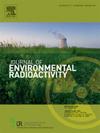日本福岛县二本松市野生啮齿动物和食虫动物体内放射性元素变化的长期研究
IF 1.9
3区 环境科学与生态学
Q3 ENVIRONMENTAL SCIENCES
引用次数: 0
摘要
2011年3月福岛第一核电站事故释放的放射性铯(134Cs和137Cs)具有较长的物理半衰期,可能长期存在于自然环境中,并继续转移给野生动物。在本研究中,我们于2012 - 2021年对野生啮齿动物(斑足鼠、银足鼠和montebelli鼠)和食虫动物(talpoidus talpoides)胃内容物和骨骼肌样本中的放射性元素活性浓度进行了定点调查。在福岛县的森林地区选择了Kuchibutoyama山和Hayama山两个采样点。在Kuchibutoyama山,野生啮齿动物和食虫动物的胃内容物以及a . speciosus和a . argenteus的骨骼肌中137Cs活性浓度呈下降趋势。137Cs活性浓度的有效半衰期(Tef)分别为7.6年、5.4年和7.4年,对应的生态半衰期(Tec)分别为10年、6.6年和9.8年(A. speciosus)。在隼山,野生啮齿动物和食虫动物胃内容物中137Cs活性浓度呈轻微上升趋势,未获得显著Tef。Tef和Tec在A. speciosus和A. argenteus骨骼肌中的137Cs放射性水平也无法估计。这些结果表明,隼山野生啮齿动物和食虫动物食用的昆虫和植物中137Cs的浓度长期保持在一定水平。2021年11月,在Kuchibutoyama山捕获的argenteus和Hayama山捕获的A. speciosus和argenteus的骨骼肌中仍检测到137Cs浓度高于1.0 kBq/kg。预计这些野生啮齿动物和食虫动物的胃内容物和骨骼肌中的137Cs浓度将在未来很长一段时间内保持不变,特别是在隼山。此外,在对野生啮齿动物和食虫动物进行采样时,我们还采集了土壤和植物样本。研究野生小型哺乳动物栖息地放射性元素活度的时间变化,以及这些变化与野生小型哺乳动物放射性元素活度的时间变化之间的关系,是今后的一项重要任务。本文章由计算机程序翻译,如有差异,请以英文原文为准。
Long-term studies on the temporal change of radiocesium in wild rodents and insectivores in Nihonmatsu City, Fukushima Prefecture, Japan
The radiocesium (134Cs and 137Cs) released by the Fukushima Dai-ichi Nuclear Power Plant accident in March 2011 has a relatively long physical half-life and may remain in the natural environment for a long period of time and continue to be transferred to wildlife. In this study, we conducted a fixed-point investigation of radiocesium activity concentrations in stomach contents and skeletal muscles samples of wild rodents (Apodemus speciosus, Apodemus argenteus and Microtus montebelli) and insectivores (Urotrichus talpoides) from 2012 to 2021. Two sampling sites in Mt. Kuchibutoyama and Mt. Hayama were selected in forested areas in Fukushima Prefecture. In Mt. Kuchibutoyama, a decreasing trend in 137Cs activity concentrations was observed for stomach contents of wild rodents and insectivores as a whole and for skeletal muscle of A. speciosus and A. argenteus. The effective half-life (Tef) of 137Cs activity concentration was estimated to be 7.6 years in the stomach contents, and 5.4 years and 7.4 years in skeletal muscle of A. speciosus and A. argenteus, respectively, with corresponding ecological half-life (Tec) of 10 years in the stomach contents, and 6.6 years (A. speciosus) and 9.8 years (A. argenteus) in the skeletal muscle. In Mt. Hayama, there was a slight upward trend in the 137Cs activity concentration in the stomach contents of wild rodents and insectivores, and no significant Tef could be obtained. Statistically significant Tef and Tec could not also be estimated for 137Cs radioactivity levels in skeletal muscle of A. speciosus and A. argenteus. These results suggest that 137Cs concentration in insects and plants eaten by wild rodents and insectivores in Mt. Hayama has remained at a certain level for a long time. In November 2021, 137Cs concentrations above 1.0 kBq/kg were still detected in skeletal muscle of A. argenteus captured in Mt. Kuchibutoyama and A. speciosus and A. argenteus captured in Mt. Hayama. It is expected that 137Cs concentration levels in the stomach contents and skeletal muscles of these wild rodents and insectivore will remain for a long time to come, especially at Mt. Hayama. Furthermore, we also collected soil and plant samples when sampling wild rodents and insectivores in this study. It is important as a future task to study temporal changes in radiocesium activity concentrations in the habitat of wild small mammals and to examine the relationship between these changes and temporal changes in radiocesium activity concentrations in wild small mammals.
求助全文
通过发布文献求助,成功后即可免费获取论文全文。
去求助
来源期刊

Journal of environmental radioactivity
环境科学-环境科学
CiteScore
4.70
自引率
13.00%
发文量
209
审稿时长
73 days
期刊介绍:
The Journal of Environmental Radioactivity provides a coherent international forum for publication of original research or review papers on any aspect of the occurrence of radioactivity in natural systems.
Relevant subject areas range from applications of environmental radionuclides as mechanistic or timescale tracers of natural processes to assessments of the radioecological or radiological effects of ambient radioactivity. Papers deal with naturally occurring nuclides or with those created and released by man through nuclear weapons manufacture and testing, energy production, fuel-cycle technology, etc. Reports on radioactivity in the oceans, sediments, rivers, lakes, groundwaters, soils, atmosphere and all divisions of the biosphere are welcomed, but these should not simply be of a monitoring nature unless the data are particularly innovative.
 求助内容:
求助内容: 应助结果提醒方式:
应助结果提醒方式:


